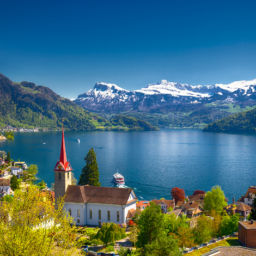In the Scottish Highlands, a remote, sheltered stretch of water in the Orkney Islands is home to Scapa Flow, one of Britain’s most historic settings. Used for centuries as a strategic trade route, these dark, chilly waters hide the remains of Germany’s World War I Naval fleet. At the end of the war, the German High Seas Fleet was at Scapa Flow under the terms of the Armistice. Fearing that the Allied Powers would seize the ships, German Admiral Ludwig von Reuter scuttled them all.
Later, in 1939, a German U-boat sank the HMS Royal Oak, one of the Royal Navy’s most renowned battleships, in the waters of Scapa Flow. It still lies on the bottom with many of the 833 souls who died when it sank. Rightfully considered some of the world’s best wreck-diving sites, seven of the German wrecks and several smaller “blockships” are protected and now make up the best dive sites in Scapa Flow.
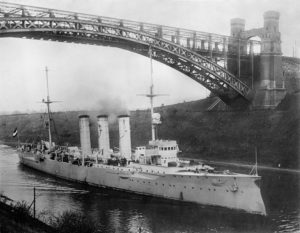
SMS Dresden
Dresden is one of two Cöln-class light cruisers that lie on the bottom of Scapa Flow. The badly damaged SMS Dresden arrived in Scapa Flow on December 6, 1918. The 350-foot (112 m) battleship lies on its port side at a maximum depth of 100 feet (38 m), stern down. One of Scapa’s best preserved wrecks, the SMS Dresden still contains many artifacts from the date of its scuttling. Look for schooling pollock in the summer, as well as the crabs and lobster that find refuge in the cracks of the ship’s hull.
SMS Cöln
Sister ship to the SMS Dresden, the SMS Cöln lies at 120 feet (36 m) on its starboard side with its shallowest point at 70 feet (22 m). The 350-foot (115 m) ship is in good condition and usually offers minimal current. The wreck will be to your left as you move toward the bow and on your right as you move toward the stern. Keep an eye out for a raised deck hatch, anchor chains and skylights set into the deck. The wreck also often features lots of small shoaling fish, pollock, cod, lobsters, crabs and sea urchins.
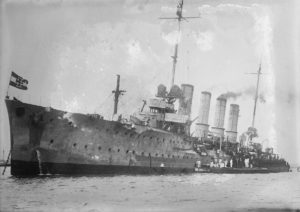
SMS Karlsruhe
Although it’s the most damaged cruiser in Scapa Flow, that’s not necessarily a bad thing when it comes to accessing the SMS Karlsruhe. Since there’s no need for intricate penetrations, divers can see quite a bit of the ship, including massive anchors near the bow, forward deck guns and the armored control tower. In 80 feet of water (25 m), divers can also log longer bottom times.
SMS Brummer
A mine-laying light cruiser, the SMS Brummer lies at 115 feet (36 m). Left largely intact by the salvage teams, the magnitude of Brummer’s weaponry makes for an impressive dive. Disintegrating more and more over recent years, divers who plan to penetrate the ship should have an experienced guide. A beautiful ship, the brass bridge is one of the highlights of the entire sunken fleet.
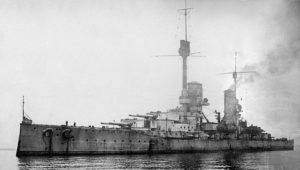
SMS Kronprinz Wilhelm
With the hull lying at 39 feet (12 m) and the bow at 120 feet (38 m) on the seabed, this wreck is a good choice for both recreational and technical divers. At 450 feet (146 m) long, the SMS Kronprinz Wilhelm is impressive due to its magnitude. Take your time and dive the wreck more than once if possible to appreciate its sheer size. Highlights include the 12-inch guns on the deeper bow section. Seeing the main armament of a dreadnought class battleship makes this one of the world’s best wreck dives.
SMS Markgraf
Lying almost completely upturned at 130 feet (45 m), the SMS Markgraf is one of Scapa Flow’s most complex dives. Remaining in superb condition, this König class battleship is one of the largest wrecks in the world at 575 feet (175 m) long. A diver’s favorite due to its sheer size, this wreck’s most impressive features are the bow, stern and rudder sections. During the spring months look out for swarms of comb jellyfish that eat algae blooms, which are caused by the warming waters.
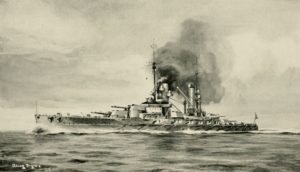
SMS König
The namesake of the König class battleships, the SMS König is different than its sister ships, the Markgraf and Kronprinz Wilhelm. Lying at 120 feet (38 m) on the sandy bottom, the wreck’s engine room is a highlight of the dive due to the number of compact components that remain. Due to extensive damage, the König is unfortunately one of the least visited ships in the German fleet, yet has a fascinating history. The König was a force of its time and the leading ship in the battle of Jutland in 1916.
During both WWI and WWII, the allies intentionally sank a number of “blockships,” which prevented enemy submarine access into the bay. Although smaller than the gigantic German cruisers and battleships, these block ships are shallower and are covered with sea life.
Blockship Tabarka
Lying stern up, this 2,200-ton block ship from 1909 is one of Europe’s best dives. At depths between 55 and 65 feet (14 and 18 m), the Tabarka is covered with various species of flora and fauna, such as anemones, lobsters, starfish, wrasse and urchins. With various access points, it’s best to dive at slack tide due to the heavy currents in the mouth of the bay. Between December and April when the visibility is clearest, light pours into the wreck’s interior from the various entry points.


